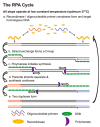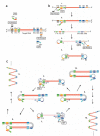Isothermal Amplification of Nucleic Acids Coupled with Nanotechnology and Microfluidic Platforms for Detecting Antimicrobial Drug Resistance and Beyond
- PMID: 35517891
- PMCID: PMC9012923
- DOI: 10.34172/apb.2022.004
Isothermal Amplification of Nucleic Acids Coupled with Nanotechnology and Microfluidic Platforms for Detecting Antimicrobial Drug Resistance and Beyond
Abstract
Antibiotic resistance is one of the serious health-threatening issues globally, the control of which is indispensable for rapid diagnosis and treatment because of the high prevalence and risks of pathogenicity. Traditional and molecular techniques are relatively expensive, complex, and non-portable, requiring facilities, trained personnel, and high-tech laboratories. Widespread and timely-detection is vital to the better crisis management of rapidly spreading infective diseases, especially in low-tech regions and resource-limited settings. Hence, the need for inexpensive, fast, simple, mobile, and accessible point-of-care (POC) diagnostics is highly demanding. Among different biosensing methods, the isothermal amplification of nucleic acids is favorite due to their simplicity, high sensitivity/specificity, rapidity, and portability, all because they require a constant temperature to work. Isothermal amplification methods are utilized for detecting various targets, including DNA, RNA, cells, proteins, small molecules, ions, and viruses. In this paper, we discuss various platforms, applications, and potentials of isothermal amplification techniques for biosensing of antimicrobial resistance. We also evaluate the potential of these methods, coupled with the novel and rapidly-evolving platforms offered by nanotechnology and microfluidic devices.
Keywords: Antibiotic drug resistance; Biosensing; Isothermal amplification techniques; Microfluidics; Nanotechnology.
©2022 The Authors.
Figures
References
-
- National Institutes of Health (NIH). NIAID’s Antibacterial Resistance Program: Current Status and Future Directions. Washington, DC: NIH; 2014.
Publication types
LinkOut - more resources
Full Text Sources










